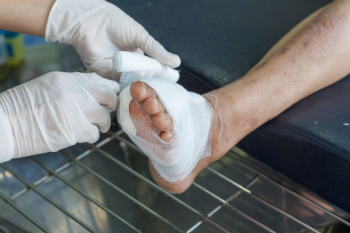
Wilmington (937) 382-2347
Fax
(513) 932-1606

Wilmington (937) 382-2347
Fax
(513) 932-1606

Preventing limb loss in diabetic patients is a significant health concern, as the majority of nontraumatic lower-limb amputations are linked to diabetic foot ulcers, or DFUs. The rise in diabetes-related amputations, especially among younger adults, underscores the importance of proactive care. Key factors that contribute to amputation can include poor glucose control, unmanaged peripheral neuropathy, and ineffective wound care. Early intervention by a podiatrist is essential to both identify and manage these risk factors. Regular foot assessments, proper wound care, and controlling blood sugar levels can significantly reduce the risk of amputation. Podiatrists play a vital role in these preventative strategies, by performing debridement, managing infections, and recommending appropriate dressings. These combined efforts can halt the progress of an ulcer and decrease the likelihood of an amputation. If you have diabetic foot problems that may lead to a loss of limbs, it is suggested that you schedule regular appointments with a podiatrist for treatment and management options.
Diabetic Limb Salvage
Diabetic limb salvage can be an effective way in preventing the need for limb amputation. If you have a foot ulcer and diabetes, consult with Dr. Gerald Perelman from Ohio. Our doctor will assess your condition and provide you with quality foot and ankle treatment.
What Is Diabetic Limb Salvage?
Diabetic limb salvage is the attempt of saving a limb, such as the foot, that has an infected ulcer, from amputation. Podiatrists also try to make sure that there is enough function in the foot after the salvage that it is still usable. Those with diabetes experience poor blood circulation, which prevents proper healing of an ulcer. If the ulcer is left uncheck, it could become infected, which could result in the need for amputation.
Diabetes is the number one cause of non-traumatic amputations in the United States. Amputation has been found to lead to higher mortality rates. This translates into higher healthcare costs, and a reduced quality of life and mobility for amputees. Podiatrists have attempted to increase the prevalence of limb salvage in an attempt to solve these issues.
Diagnosis and Treatment
Limb salvage teams have grown in recent years that utilize a number of different treatments to save the infected limb. This includes podiatrists that specialize in wound care, rehabilitation, orthotics, and surgery. Through a combination of these methods, limb salvage has been found to be an effective treatment for infected limbs, and as an alternative to amputation. Podiatrists will first evaluate the potential for limb salvage and determine if the limb can be saved or must be amputated.
If you have any questions, please feel free to contact our office located in Wilmington, OH . We offer the newest diagnostic and treatment technologies for all your foot care needs.